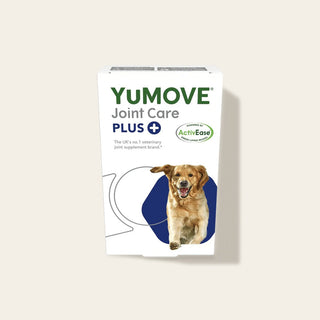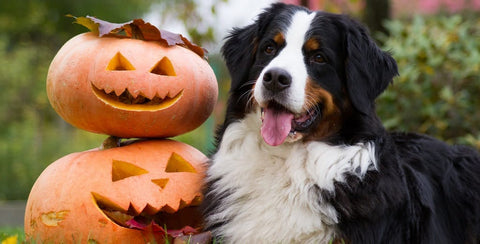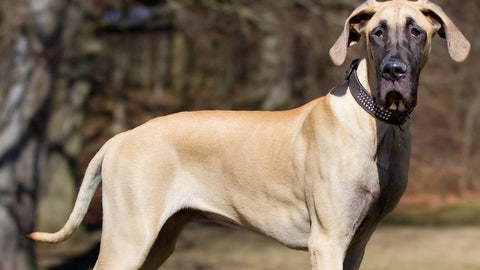
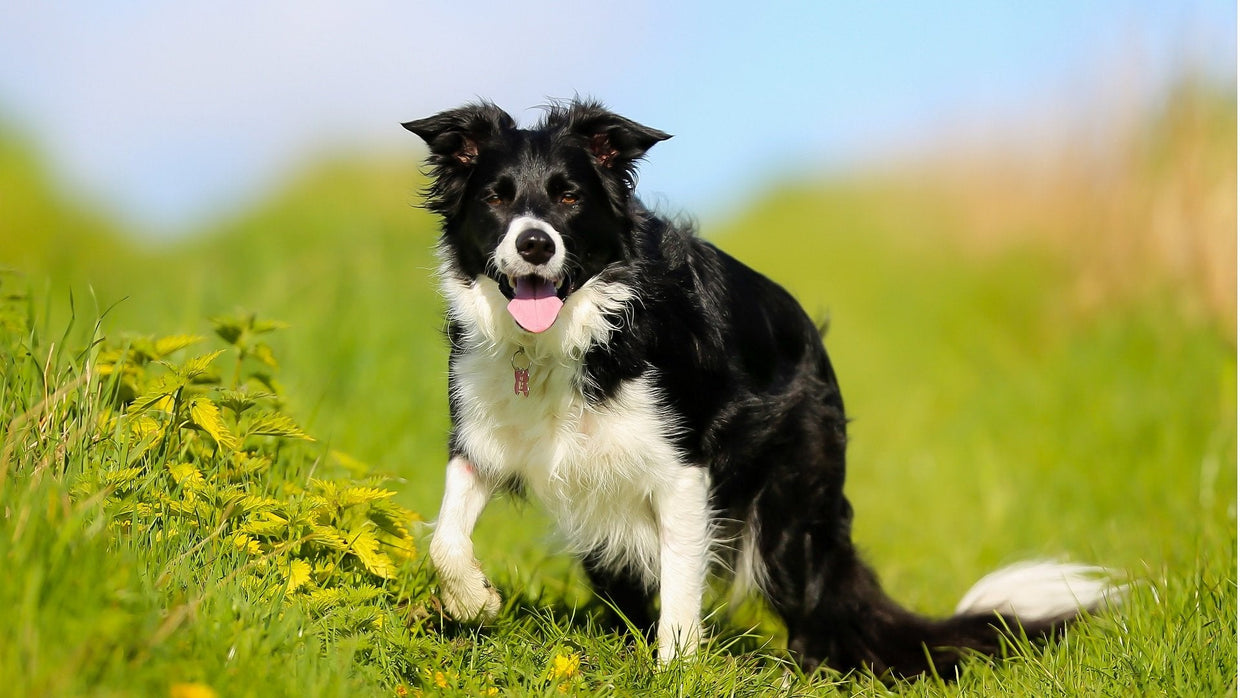
How to help a dog with anxiety
Dog anxiety comes in all shapes and sizes, from the random fears, like hot air balloons, clouds and cats, to the more familiar, such as fireworks and (ssssh) the V.E.T. It’s common for most dogs to suffer from anxiety from time to time. So how can you help them overcome their fears?
Helping your dog with anxiety is a combination of short-term practical tips for keeping your dog calm, and a long-term plan to address the causes. Here are our tips for both and what YuMOVE dog supplements you may need to help your pup...
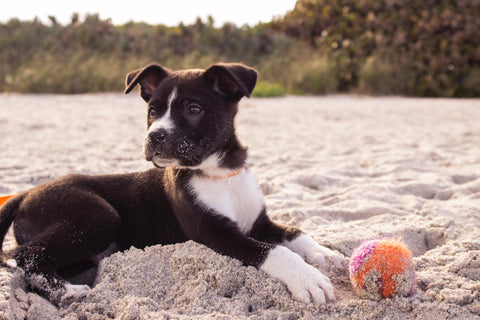
Short term: Practical tips to help a dog with anxiety
- Never, ever punish an anxious or fearful dog – it’s upsetting when your dog is destructive, barks excessively, lunges or has accidents, but always be kind. Punishment will make their anxiety worse, deepen their fears, and can even lead to more extreme reactions.
- Avoid whatever upsets them (if possible) – until you can get some expert help and start working on how they feel about it.
- Exercise it out – like in humans, exercise can be a great way to burn off stress and anxiety in dogs. A good run before leaving your dog home alone can really help some dogs with mild separation anxiety. A full tummy can help, too.
- Invest in a wrap - Thundershirts and give the feeling of a comforting hug, which helps to calm and reassure when your dog is anxious. They’re particularly good for fearful travellers and dogs who hate fireworks.
- Keep calm and carry on – be mindful of the emotional cues you give your dog. If you react to their anxiety by becoming tense and stressed, you can reinforce fears, so try and keep calm and upbeat, with loose body language and soft, happy tone of voice.
- Let them get close – physical contact can really help some stressed and anxious dogs, so let them snuggle up or sit closer to you if they seek comfort. Don’t forget that dogs read your emotional cues too, so don’t make too much fuss of them, and act as ‘normal’ as possible.
- Try calming music or pop Radio 4 on a low volume – this can be helpful for dogs with mild separation anxiety or noise phobias.
- Make a doggie den – if your dog is scared of something seasonal (fireworks, visitors around Xmas or Halloween), try making a safe, quiet den for them – a blanket over their crate, putting their bed in a big cardboard box covered with blankets, or creating a safe, cosy hidey hole behind the sofa or under a table with a double duvet over the top.
- Use food and distractions – a game with their favourite toy, or some tasty treats can switch your dog’s focus from whatever they’re scared of to you (and the rewards on offer!)
- Try a calming supplement – different supplements work in different ways, but the natural, scientifically-proven ingredients in YuMOVE Calming Care for Dogs help them cope with stress by making your dog feel calmer and happier. This is good news in the long term too, as they become more receptive to behaviour therapy techniques, which in time leads to a happier, more playful and confident dog.
Long term: 5-step approach to reduce dog anxiety
Dogs, like people, are all different – and so are their fears and anxiety triggers. This means there’s not really a single, simple solution to help fearful or anxious dogs feel better in the long term. However, we’d broadly recommend a 5-step approach to help reduce anxiety in dogs.
Step 1: Spot what’s scary
However clever your dog might be, he or she can’t tell you when they’re feeling frightened. That’s why – as pet parents – we all need to take the time to learn a little bit of dog. Here are some of the signs of dog anxiety:
|
Obvious |
Less obvious |
Subtle signs |
|
Shaking and trembling |
Ears down or back |
Wide eyes |
|
Tucked tail |
Restlessness - won't 'settle' |
Worried face |
|
Hiding |
Being clingy or seeking physical contact |
Raised heckles |
|
Backing away |
Turning away |
Yawning |
|
Aggressive responses - lunging, snapping and growling |
Accidents in the house |
'Shaking off' - like when they're wet |
|
Destructiveness |
Barking and howling |
Lip-licking |
By spotting the subtle or early signs of dog anxiety, you can work quickly to help your dog feel more confident. This is important, as it can avoid more serious reactions – like aggression – and deeper, more ingrained fears that are more challenging to resolve.
Step 2: Short-term management
You’ve identified your dog’s ‘triggers’ – now what should you do? Steer clear of them! If possible, change your routine so your dog doesn’t come into contact with whatever they find scary. This will stop their reactions escalating while you identify the next steps to take with some expert support.
Step 3: Talk to the experts
Some of the signs of dog anxiety can also be indicators that something’s not right physically. A quick trip to the vets will rule out anything medical – and can be a great place to start when it comes to tracking down a good behaviourist in your area.
When it comes to working with fearful or anxious dogs, we always recommend working with a fully certified behaviourist. Always check to see they’re on the register of ASAB Certified Clinical Animal Behaviourists (CCABs). This ensures they’re an expert and are up-to-date with the latest information and techniques.
Out-of-date advice can do a lot more harm than good to your dog’s behaviour and welfare. That's why it’s important to be careful and do your homework when you’re seeking behavioural advice.

Step 4: Make a plan – and stick to it
Working with your expert, the next step is making a behaviour therapy plan to tackle your dog’s anxiety. The strategy will depend on your dog, their triggers and your situation. Typically, it might include:
- Desensitisation and counter-conditioning exercises and techniques.
- Medication to relieve anxiety – that might mean antidepressants for dogs.
- Having fun with play, reward-based training games and exercise – to help release feel-good hormones and calm anxiety.
- Changes to you and your dog’s routine.
- Natural calming supplements – like YuMOVE Calming Care for Dogs – to support behavioural therapy.
Step 5: Be calm, kind, patient and consistent
Helping your dog feel happy and confident isn’t always easy, and their behaviour won’t change overnight. You’ll need to really commit to your expert’s behaviour modification programme and put in the time and effort to help your dog feel more confident and in control.
Though calming supplements for dogs and medication can help manage their symptoms of stress and anxiety, the most important thing is to change how your dog feels about whatever he or she finds scary with a behaviour modification programme – and that takes kindness, time, patience and commitment. But put in the love and care, and your dog will thank you ten times over with a happier-ever-after together.
Does your dog get fearful or anxious? What upsets him or her? Have you helped your dog get over anxiety? Do you have any positive training tips that other pet parents might find useful? Please do leave a comment and share with our community.
